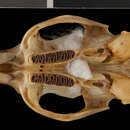tr
kırıntılardaki isimler


The prehensile-tailed hutia (Mysateles prehensilis) is a small, furry, rat-like mammal found only in forests on Cuba. It is the only member of the genus Mysateles. It climbs and lives in trees where it eats only leaves, and it is threatened by habitat loss.[1] The prehensile-tailed hutia is a member of the hutia subfamily (Capromyinae), a group of rodents native to the Caribbean that are mostly endangered or extinct. There is one subspecies, M. prehensilis gundlachi (also known as Chapman's prehensile-tailed hutia or Gundlach's hutia).
The genus name Mysateles derives from the two ancient greek words μῦς (mûs), meaning "mouse, rat", and ἀτέλεια (atéleia), meaning "incomplete, imperfect".
Within Capromyidae, the closest relative of Mysateles is the genus Mesocapromys. Both genera are the sister group to Capromys, and then Geocapromys is a more distant genus. In turn, these four genera belong to the tribe Capromyini, and are the sister group to Plagiodontia.
Genus-level cladogram of the CapromyidaeTrinomys (Atlantic spiny rats)
Capromyidae Plagiodontini Capromyini The cladogram has been reconstructed from mitochondrial and nuclear DNA characters.[2][3][4][5][6][7]Several other hutia species such as Garrido's hutia (Capromys garridoi) and the black-tailed hutia (Mesocapromys melanurus) were formerly classified in Mysateles, but phylogenetic evidence found them to belong in different genera, leaving only M. prehensilis in Mysateles.[8]
A subspecies, Mysateles prehensilis gundlachi (also known as Chapman's prehensile-tailed hutia or Gundlach's hutia) was previously considered a separate species (Mysateles gundlachi).[9] The Isla De La Juventud tree hutia (M. p. meridionalis) was also previously considered a separate species, but was found to be a subspecies by phylogenetic studies.[8][10]
Its karyotype has 2n = 34 and FN = 54–56.[11]
The species is found in both primary and secondary forest. It is listed as near threatened on the IUCN Red List. Although locally common in some areas, it is in decline and is threatened by deforestation and habitat fragmentation.[1]
The prehensile-tailed hutia (Mysateles prehensilis) is a small, furry, rat-like mammal found only in forests on Cuba. It is the only member of the genus Mysateles. It climbs and lives in trees where it eats only leaves, and it is threatened by habitat loss. The prehensile-tailed hutia is a member of the hutia subfamily (Capromyinae), a group of rodents native to the Caribbean that are mostly endangered or extinct. There is one subspecies, M. prehensilis gundlachi (also known as Chapman's prehensile-tailed hutia or Gundlach's hutia).
Mysateles gundlachi es una especie de roedor de la familia Capromyidae.
Se encuentra en la isla de Cuba.
Su hábitat natural son: bosques, de tierras de baja altitud.
Se encuentra amenazada de extinción por la pérdida de su hábitat natural.
Mysateles gundlachi es una especie de roedor de la familia Capromyidae.
Mysateles gundlachi Mysateles generoko animalia da. Karraskarien barruko Capromyidae familian sailkatuta dago.
Mysateles gundlachi Mysateles generoko animalia da. Karraskarien barruko Capromyidae familian sailkatuta dago.
군드라흐후티아 또는 채프먼잡는꼬리후티아(Mysateles gundlachi)는 후티아과에 속하는 설치류의 일종이다.[1] 잡는꼬리후티아의 아종으로 간주하기도 한다.[1][2] 쿠바의 저지대 습윤 숲에서 서식한다. 서식지 감소로 위협을 받고 있다.